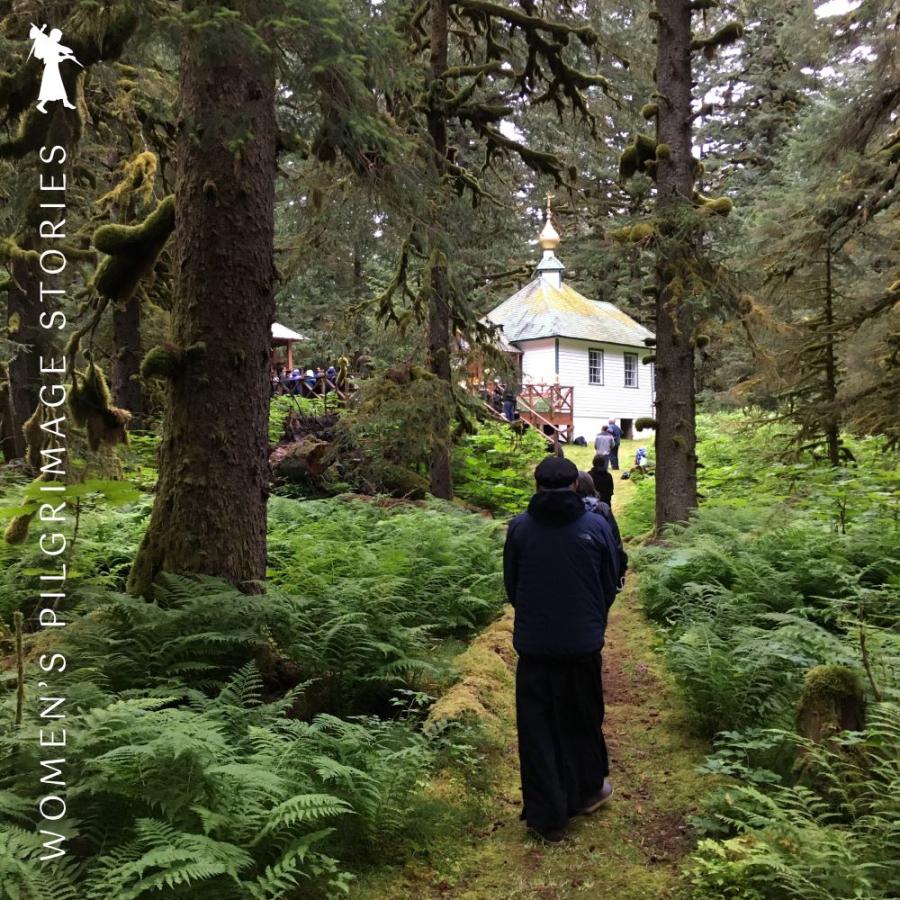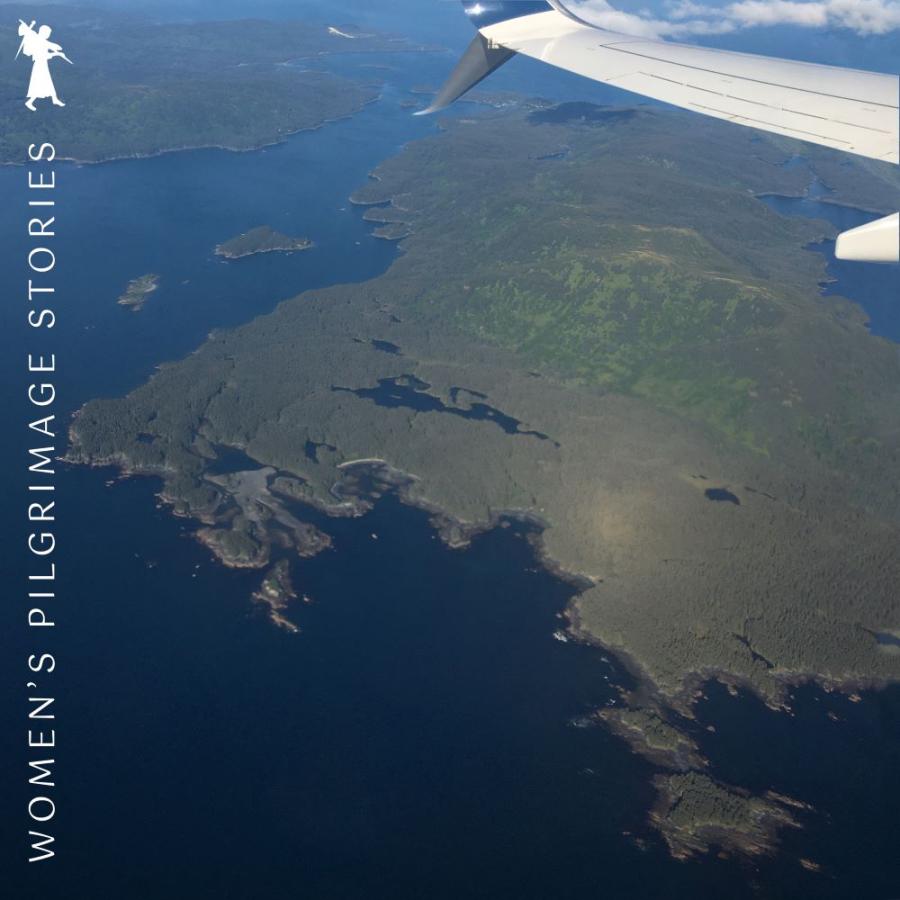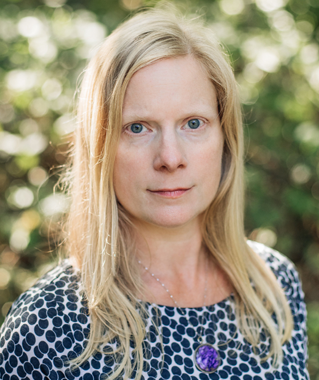
Then he said, “Do not come near; put off your shoes from your feet, for the place on which you are standing is holy ground.” —Exod. 3:5
“Carrie, take off your shoes!” called my friend Betsy from the shore, as the small fishing boat I was on came to a stop. There was no dock, and the boat could not quite make it all the way to dry land, so a slippery wooden plank was placed on the stern.
The occasion for this watery egress was a pilgrimage to Spruce Island on Saint Herman’s feast day. The Alaskans among us wore their Xtratuf boots and others decided simply to drench their shoes as they shuffled cautiously down the plank and waded the last few yards to the beach, even though the August weather felt more like November. Thanks to Betsy, I pulled off my sneakers and rolled up my pants as quickly as I could, not wanting to slow the disembarking.
My path to the sacred ground of Spruce Island began decades ago. My father Eustace (may his memory be eternal) had an affinity for Saint Herman. The son of Russian immigrants (who were from what is now Belarus), he was intrigued by the Russian Orthodox saints of North America: Saint Innocent, Saint John Maximovitch, Saint Herman, and others. Their stories of immigration and encounters with our continent were relatable to him. My father possessed a uniquely intense and guileless piety, which I have no doubt allowed him a sympathetic connection with Saint Herman, who, by all accounts, shared the same qualities. My hometown priest always liked to tell the story of my father, then in his 70s, climbing through a stopped train that blocked the road to the church to make it to Vespers on time. My father dearly wanted to go to Spruce Island to pay his respects to Saint Herman. He had begun to make plans when he was diagnosed with his final illness, and his pilgrimage never came to fruition.
I’d known for years that I needed to complete this quest for him. He did not ask this of me; it was more of an intuitive response to unfinished family business. Not that my pilgrimage was without ambivalence. I had deep admiration for Saint Herman, and the children’s book about his life by Dorrie Papademetriou is well-worn in our house. But I did not have my dad’s intense connection. Also, I lacked what I thought should be the spirit of a gung-ho pilgrim, who is excited to worship at the site of a great saint and receive succor or inspiration. Instead of zealous, I was spiritually beleaguered. For a variety of reasons, I was in a dry season. Which left me somewhat ambivalent about the pilgrimage; I did not anticipate or hope for revelation on the journey. I thought of the words Saint Gertrude heard in her encounter with Jesus Christ: “I require nothing of you but to come to me empty that I may fill you.” I waded through the North Pacific to arrive on Spruce Island empty and without much hope of being filled.
A few hours earlier, it was not certain that we would make the journey from Kodiak to Spruce Island. Monk’s Lagoon, the access point to Saint Herman’s skete on Spruce, faces the open Pacific, and semi-predictable winds sometimes create high waves and difficult conditions, not to mention the treacherous tides and currents of this area. The group pilgrimage is occasionally canceled altogether due to sea conditions. One comes knowing that one’s final destination might not be reached.
During the two days of pilgrimage events, plans for the crossing kept changing based on weather forecasts. I arrived at the marina Monday morning well before six o’clock not knowing if the crossing would be possible. As I approached the crowd of cassocked and long-skirted people, I noticed that life jackets were being passed out. We were going.
Our group of seventy or so pilgrims climbed over the railing onto a freighter that normally delivers petroleum and other goods to the surrounding islands. We felt like cargo, as there was no place to sit—just a large metal deck on which to teeter. Many of us clung to the exterior railing, and as I stiffened my legs to stay upright during the choppier parts of the ride, I wondered if I would feel sore tomorrow. As the sky became lighter, I observed my fellow pilgrims, quiet and tensely focused on the passage. People talked in small voices, if at all. The pilgrims were young and old. Cradle and convert. Many were Native Alaskans but others came from all across the United States (and had it not been a pandemic year, they would have come from all around the world).
When we arrived at Monk’s Lagoon, our boat was not able to pull all the way to the shore, and it was decided that we would be ferried fifteen people at a time in a smaller fishing boat, which itself could not quite make it to shore, necessitating the hasty removal of shoes. After the shock of the cold disembarking, I picked igneous pebbles out from between my toes on the shore. Putting my shoes back on, I started up a little slope with Betsy and her husband, Father Marc, sharing the sort of mutual understanding and appreciation that allowed us to walk comfortably in silence. The walk from Monk’s Lagoon to Saint Herman’s skete is not long (maybe half a mile), but it is special. There was no hurry, and we made our way carefully, thoughtfully, quietly. The spongy, moss-thickened path softened noise. We heard only dripping sounds coming from the outsized trees in the temperate rainforest and bird calls. Kiosks with icons of the North American saints graced the path. As we walked, I felt lighter, more buoyant in body and spirit.
We paused at a small graveyard containing a few graves of monks and others close to Spruce Island. This was Betsy’s first opportunity to see the final resting place of a priest friend who had died young many years ago. Just the previous day, she had poignantly described his death to me. At the funeral, his widow, dressed all in white, sang the Resurrection hymn, which was remarkable and spiritually formative for all present. Now, at his grave, Betsy teared up. To my surprise, so did I. My heart tightened as these graves brought to mind my father’s grave, far away in West Virginia, with the same triple- bar cross above it. The reality of death witnessed here—the young priest’s, my father’s, and what will be my own—sent a tremble of bright sadness through my body.
As we approached the little chapel surrounded by venerable, lichen-enshrouded Sitka spruce, we heard the voice of this same widowed cantor along with the priests and the voices of the faithful. The Liturgy was underway, and the hierarchs were inside the tiny chapel while the faithful stood outside on a large deck, an ersatz nave. I assume this was a pragmatic decision—so many clergy were present, and the building was quite small—rather than a pandemic-dictated choice, but it served both purposes.
I relished the experience of an outdoor Liturgy, something rare in the Orthodox world. The fresh air, the presence of the trees, and the Blackcapped Chickadees offering their own doxologies from their perches in the forest—I savored it all. Red Crossbills repeatedly circled and called overhead, and human voices in praise merged with the the sounds of natural world. I stood not on the deck—I was one of the last arrivals and it did not seem that there was room—but on the ground, thankful when it sprinkled for the shelter of a little red cedar tree.
I noticed a small door cut into the crawl space underneath the church. Occasionally a pilgrim would get down on hands and knees and crawl inside. I know what that is, I thought to myself. As I approached the little door, an eager woman with long skirts and hair asked me if I had a Ziploc bag, explaining that I could take a bit of dirt home and when feeling sick make a tincture with water and drink it. I declined the offer. She looked surprised and disappointed, so I explained that I had picked up several pebbles from Monk’s Lagoon. “Very good,” she said, patting me on the back, affirming that my relic-stashing impulse passed muster.
I crawled in. As I had suspected, this was the original burial site of Saint Herman. A dirt space under the chapel, it is sacred ground. I could see nothing, but I smelled the water-soaked earth around me. As my eyes adjusted, the former site of the grave with an icon of Saint Herman placed in the dirt came into view. Again, my father filled my thoughts. If he had made it here, even in his seventies, he most certainly would have gotten down on hands and knees and reverently crawled into this dank space, with a Ziploc bag in hand. Tears surprised me again. I prayed, thanking God for people like Saint Herman and my father, appreciating that is a gift to have those whose faith is great among us and to remember them.
Liturgy was followed by snacks and drinks on the beach, and then it was time to reload the boat, knowing the window of smooth seas was closing. This time, our skipper brought his boat all the way to shore, and we were able to walk right on with dry feet. Pilgrims cheered their appreciation as they boarded, but I felt it was a little anticlimactic; I’d been looking forward to another baptism in the Pacific and a trip up the slippery wood plank back onto the boat.
On the way to Spruce, pilgrims had mostly stayed within their family or friend groups, but on the way back, the camaraderie was heightened. Even though the sea was no smoother, we clung to the railing less, turned towards each other more. Different groups mingled and new conversations were started. I spoke with the matushka next to me and learned that her father also had a special connection with Saint Herman. The tears came again as I spoke to her, but they were understood and mirrored. She said, “My dad always told me, when you are in trouble, pray to Saint Herman, he comes quickly.” We squeezed hands.
As we slowly started to motor out of Monk’s Lagoon, this matuskha and other women near me began to sing. First Saint Herman’s troparion, “Joyful North Star of the Church of Christ,” then “Lord save your people,” and other Orthodox greatest hits. The women were Native Alaskans and deftly moved from English to Slavonic to Yupik to Aleut. Their voices rose up as Spruce Island receded behind us. I wanted to join in (to the English versions), but my throat was too tight, so I listened and let their voices fill me. Something unspooled a bit more inside of me, and I experienced an ease of body and spirit.
As my flight lifted from the Kodiak earth the next morning, I made the sign of the cross, as I always do when flying: blessing the plane, the pilots, all within, and praying for a safe journey. This time, the two passengers next to me simultaneously crossed themselves, which delighted me—that never happens! We had already recognized each other from the pilgrimage; I was sitting next to the same matushka I’d spoken to on the boat, along with her husband who serves as a priest in a village near Homer. We talked for a bit, reminiscing about our pilgrimage experience. I noticed Spruce Island below us through the plane window, and Matushka used my phone to take a picture from the air.
I came home with a remarkably good photo of Monk’s Lagoon and an appreciation for the ways that the physical experience of pilgrimage is just as significant as the spiritual, because these things are bound up together. Of course they are, but it took things like wading through the ocean, picking pebbles from between my toes, hearing bird calls during Liturgy, and crouching in the dark on damp earth to remind me that the senses are conjoined with the soul. Knots inside me from my own ambivalence or spiritual poverty had not untied entirely, but they had relaxed. With my full person, I experienced the freedom or acceptance of the bright sadness I’d known on Spruce. My journey did not include an epiphany nor a spiritual height, but I experienced the no-less-meaningful little mercies and beauties of the body’s sojourn in pilgrimage—and in all of life—on sacred ground. “Take off your shoes,” indeed.


This article was originally published in The Wheel, ISSUE 31–32 | FALL 2022–WINTER 2023. Reused with permission.
Carrie Frederick Frost is the new Chair of Saint Phoebe Center for the Deaconess, and a well-regarded scholar of modern Orthodox Christianity who teaches at Western Washington University and Saint Sophia Ukrainian Orthodox Seminary. Her organizational skills are legendary, such that she was not only a founding board member of the International Orthodox Theological Association and just stepped down as its secretary, but was also one of the key organizers of its January 2023 mega-conference.


